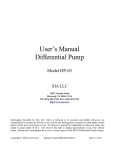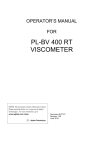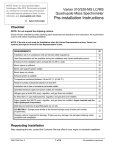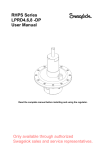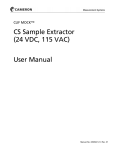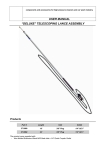Transcript
NOTICE: This document contains references to Varian. Please note that Varian, Inc. is now part of Agilent Technologies. For more information, go to www.agilent.com/chem. Carrier Gas Refill Assembly manual Micro-GC field case, CP-200X portable version and Quad systems Your Micro-GC Field Case, CP-200X portable version or Quad system is equipped with a refillable, high pressure carrier supply tank(s) which has been approved to 12000 kPa, and has an internal volume of 300 cc. When the instrument is in use the pressure should not drop in the red area since all systems need at least 550 ± 10 kPa (80 ± 2 psi) to working properly. Refilling is done by means of a Carrier Gas Refill Assembly. This special tool is connected directly to the valve on the gas supply cylinder. Because this connection differs from country to country, Varian, Inc. offers a range of Refill Assembly's to meet all major standards. If the connector of this device, despite a careful choice, does not match your supply unit, ask your local gas supplier for the right part. It should have ¼" NPT male thread at the other end. Exchanging is easy. Pressure gauge 10000 to 12000 kPa, close both valves on refill assembly and gas supply cylinder. By that time it is possible that the relief valve may have started to blow, this is normal. The relief valve is meant to limit the pressure in the carrier gas cylinder. 8. Disconnect ⅛" tube from the refill nut. Now escaping gas comes from the Refill assembly letting off pressure. Cap off the refill port. The carrier gas cylinder can only be filled to the maximum when the pressure in the gas supply cylinder has sufficient pressure to allow that. If the gas supply pressure has dropped below the set point of the relief valve the gauge on the refill assembly will indicate this pressure when both valves are open. Relief valve Additional refill information In case the carrier supply cylinder depressurized completely and is possible contaminated with air, proceed with the next steps: 1. 2. Valve Connection to gas supply cylinder Connection to carrier fill port High-pressure gas stores an incredible amount of energy and is dangerous in its own right even if the gas is inert like He or N2. However, if caution is not practiced, filling your tank can be EXTREMELY HAZARDOUS. Filling the tank can be done safely if the following steps are followed. Refill procedure 1. 2. 3. 4. 5. 6. 7. Install Refill Assembly onto gas supply cylinder. Check and make sure that the valve on the Refill Assembly is closed. At the back of the Micro-GC, remove the ⅛” nut at the carrier gas refill port (refer to the appropriate user manual). Connect the ⅛" tube from Refill Assembly to the refill port. Finger tighten and loosen the nut ¼ turn. First, open the valve on gas supply cylinder, then slightly open valve on Refill Assembly just a tiny little bit and listen for gas leaking through the nut. (This purges Refill Assembly so that no air enters the gas carrier gas cylinder). When refill assembly has been sufficiently purged, tighten the refill port nut. While watching pressure gauge on refill assembly, slightly open valve a little more. When pressure on gauge reads © 2009 Varian, Inc. All Rights Reserved Install Refill Assembly onto gas supply cylinder. Check and make sure that the valve on Refill Assembly is closed. 3. Close the carrier pressure valve (at the Micro-GC). 4. Disconnect at the back of the Micro-GC the tubing connecting the internal gas cylinder to the Micro-GC carrier gas in-port (refer to the appropriate user manual). 5. At the back of the Micro-GC, remove the ⅛”nut at the refill port (refer to the appropriate user manual). 6. Connect the ⅛" tube from Refill Assembly to the refill port. Finger tighten and loosen the nut ¼ turn. 7. First, open the valve on gas supply cylinder, then slightly open valve on Refill Assembly just a tiny little bit and listen for gas leaking through the nut. (This purges Refill Assembly so that no air enters the gas carrier gas cylinder). 8. When refill assembly has been sufficiently purged, tighten the refill port nut. 9. Fill the carrier gas cylinder to about 1500 kPa. 10. Turn carrier gas valve open, relieve pressure in carrier gas cylinder, and close valve. 11. Purge this way at least twice, don’t close valve the last time, but reconnect the removed tubing. 12. While watching pressure gauge on refill assembly, slightly open valve a little more. When pressure on gauge reads 10000 to 12000 kPa, close both valves on refill assembly and gas supply cylinder. By that time it is possible that the relief valve may have started to blow, this is normal. The relief valve is meant to limit the pressure in the carrier gas cylinder. 13. Disconnect ¼" tube from the refill port. Now escaping gas comes from the Refill assembly letting off pressure. Cap off the refill port. Printed in the Netherlands CP505278 Rev:04 November 2009
